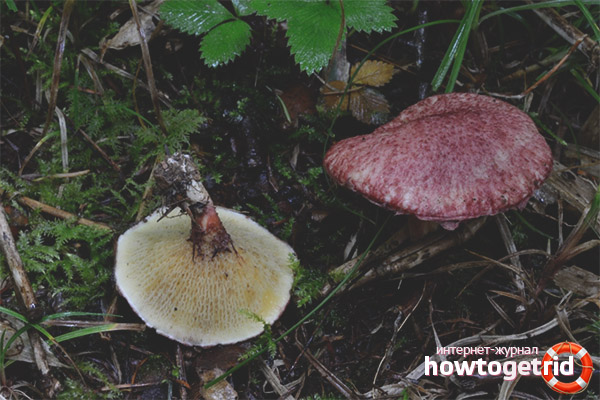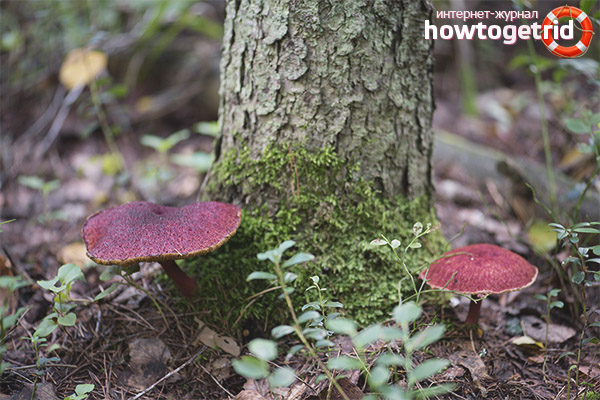The content of the article
The marsh boletin mushroom is included in the category of conditionally edible representatives of the mushroom kingdom. Included in the ranking of ten oldest mushrooms in the modern world. This species lives in deciduous or mixed forests. It can grow with both low and high moisture. It occurs in the period from mid-summer to mid-autumn. Most common in the forests of the Far East, in the east and west of Siberia, as well as in the Asian part of Eurasia and North America.
Basic information
The fungus comes from the department of Basidiomycetes, class Agaricomycetes, order Fleet, Butterfly family. Other name for Boletin swamp: marsh marsh, false butterdish, ivanchik. People also call a mullein, a mushroom of cows, a kid, a sheep, a moss fly.
The appearance of the mushroom
- A hat. The size of the hat in a circle is from 5 to 10 centimeters. It has a flat, slightly convex shape, in the center of a small tubercle, similar to a small pillow. The hat itself is rather dry and fleshy. The representatives of the species that have just appeared have a burgundy, ripe cherry or purple color. In the process of growth, the hat is put pale, with a yellow or ocher hue. There is a tubular layer painted in a yellowish tint, which later turns into brownish. He goes down the leg, and at an early age he has a dark pink coverlet on top. The tubes have radially elongated recesses, their size is up to 4 mm. The color of the spore powder is pale brown.
- Pulp. The pulp of the fungus is inherent in a yellowish color, it sometimes casts bluish. Has a bitter aftertaste. At an early age, boletin does not have a clear odor, it smells rather unpleasant with age.
- Leg. The mushroom leg in height can be from 4 to 7 centimeters, diameter from 1 to 2 centimeters. To the bottom, the leg begins to thicken. The top is a yellowish hue, under a ring with a red color, but no darker than the cap of the mushroom itself.
Mushroom habitats
Boletin marsh chooses for the growth of forests with larch and mixed forests. It occurs both in areas with low and high humidity. Widely distributed in Siberia, Asia, North America, found in the cultural landscapes of Russia.
Time to search
Can I eat a mushroom
This type of fungus is considered conditionally edible. In ancient times, it was eaten in our territories, but today, foreign experts consider it unsuitable for food.
The mushroom has a rich bitter taste, so no one really burns with the desire to eat it. Boletin is used for pickling and pickles, before which it must be subjected to good processing.
There are only whole, recently collected and mature representatives of the species. Before cooking, they are soaked for three days, periods must be changed to fresh water.
For the manufacture of brine, you need to take half a glass of plain water, 2 tbsp. l salt, a flower of dried cloves, dill per kilogram of mushrooms. Boletins should be put in boiling water, add everything you need, and cook for half an hour, constantly stirring. After immersing the mushrooms on the bottom of the pan, turn off the stove and put the prepared mushrooms in a large bowl so that they cool.
Varieties

Boletin Asian
It grows in the west and east of Siberia, in the Amur River region, in the south of the Urals. Can be found next to larch trees. The hat can measure up to 12 centimeters.It is usually convex, dry, covered with scales, purple hue. The pores of the tubular layer are yellow at an early age, then are replaced by a dark green color. The flesh is yellowish, at the transition the hue remains the same. Leg is shorter than cap. It has the shape of a cylinder, a ring, yellowish above, purple below. The mushroom is harvested from late summer to early autumn.
Boletin polonyzhkov
It looks like a swamp, sometimes called a polovezhovy moss fly. The hat is thin, up to 17 centimeters in size. At an early age in the form of a bell, later convex with tubercles. At the edges of the cap there are remains of the bedspread. The color is initially brown, later becomes rusty or yellowish. The surface is dry, not sticky, there are dark scales, there is a light fluff.
At the bottom, the leg has a root appearance, it becomes thicker towards the center. The rain can be watery. On top of it is a sticky ring. The layer with the tubes is not long, the tubes themselves go down the leg, after which they join the cap. The shade of the tubes, light yellow, later changes to brownish-brown, it can give off green. The radical arrangement of the tubes. Expanded pores, pointed edges. The spore layer is olive tint, the spores themselves are in the form of ellipses.
Mushroom pulp is located in fibers, to the touch elastic, yellowish tint. The taste is acceptable, the aroma is not pronounced. It grows in the forests of cedars and larch. Gather mushroom from late summer to mid-autumn. Boletin centipede is conditionally edible. Eat it fresh or dried.
Poisonous and non-edible varieties
How to grow a mushroom at home
Since this mushroom is not valuable either as a medicinal or as a food, no one grows it at home.
Interesting information about the swamp
The fungus has mycorrhiza only with larches, so you can meet it only next to this type of tree.










Submit